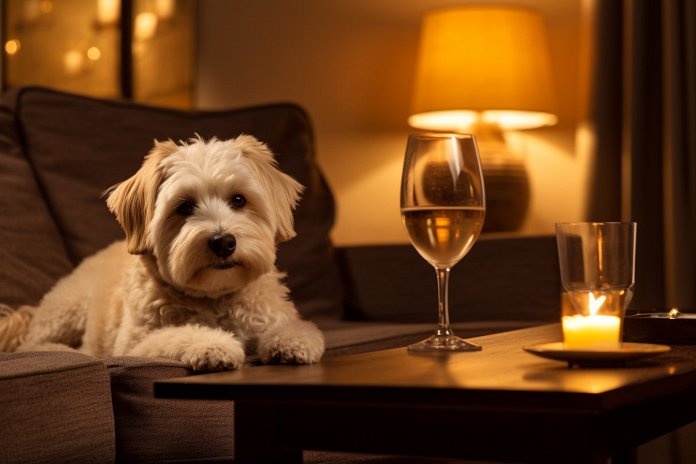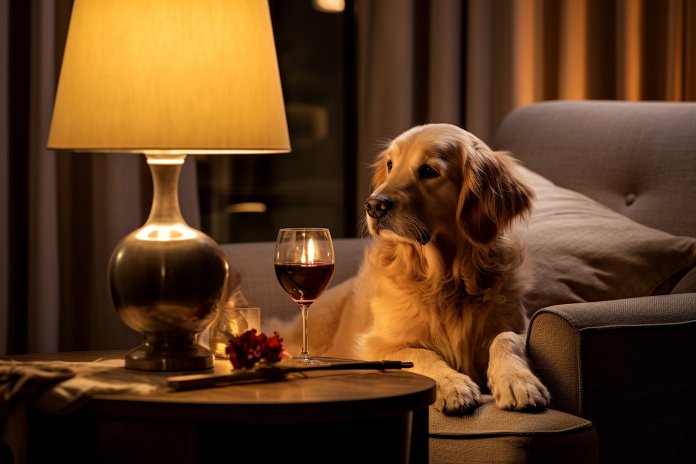
We want to emphasize that it is extremely dangerous to feed your dog wine. Even a small amount can be harmful, especially for smaller dogs. While accidentally lapping up a tiny drop off the floor may not require immediate action, giving your dog wine or any other alcohol can have negative effects on their health. Let’s explore why wine and dogs should never mix.
Signs Your Dog has Ingested Wine
Dogs are not equipped to process alcohol like humans, and they can suffer from alcohol poisoning even with a few sips. It is crucial to be aware of the symptoms if your dog accidentally consumes wine. Look out for signs such as lack of coordination, sluggishness, stumbling, difficulty walking, decreased body temperature, lower blood pressure, panting, shaking, seizures, vomiting, and other gastrointestinal issues. If your dog exhibits any of these signs, seek veterinary care immediately.
Body Language
Here are some body language cues that may indicate your dog has had too much wine: shaking, panting, dropped ears, pacing, freezing, lack of focus, head bobbing, and dilated pupils.
Other Signs
Watch out for additional signs such as drunk-like behavior, seizures, lethargy, stumbling, tripping, falling, vomiting, or diarrhea.
The History of Wine and Dogs
While wine is a natural process, dogs haven’t been exposed to it without human involvement. Dogs may be curious and want to investigate when their owners are drinking wine. However, it is our responsibility to prevent dogs from ingesting wine, as it can be harmful or even fatal to them. Owners leaving open bottles unattended or giving their dogs wine unknowingly contribute to wine-related issues in dogs.
The Science of Wine and Dogs
Wine is especially dangerous for dogs because they cannot process alcohol like humans can. Even a small amount can have severe effects on dogs, including diarrhea, vomiting, tremors, coma, depression of the central nervous system, and death. Due to their smaller size and inability to process alcohol, a small amount of wine for a dog is equivalent to a large amount for a human. Keep your dogs away from wine, beer, and other alcohols.
Training Your Dog to Stay Away from Wine
It is important to train your dog to stay away from all types of people food. Start with basic obedience commands like “no,” “sit,” “stay,” and “leave it.” Teaching your dog that begging is inappropriate is crucial to prevent them from consuming wine from less knowledgeable individuals. If your dog struggles with this command, consider keeping them in their crate during meal times to avoid any issues.
If you still want to include your dog in celebrations, consider getting pup-safe dog wine that is made from non-toxic ingredients. These wines have flavors dogs love and contain beneficial vitamins and minerals.
“Remember, wine and dogs don’t mix – it’s a dangerous game to play.”

Tips & Things to Know
1️⃣ Never give your dog wine or any other type of alcohol. Even a small amount can be incredibly dangerous for your dog, especially if they are smaller in size. It’s not worth risking their health for a cute photo or Instagram moment.
2️⃣ Be aware of the signs that your dog has ingested wine. Look out for symptoms like lack of coordination, sluggishness, tripping and stumbling, decreased body temperature, panting, shaking, seizures, vomiting, and gastrointestinal issues. If you notice any of these signs, it’s important to seek veterinary care immediately.
3️⃣ Train your dog to stay away from people food, including wine. Teach them basic obedience commands like “no,” “sit,” “stay,” and “leave it.” Also, discourage begging behavior as it can lead to others unknowingly giving your dog wine. Consider using pup-safe dog wine as a safer alternative if you still want to include your dog in celebrations.
Frequently Asked Questions, Answered ✅
1. Can dogs safely consume wine or other types of alcohol?
No, dogs should never be given wine or any type of alcohol as it can be incredibly dangerous and harmful to their health.
2. What are the signs that a dog has ingested wine?
Signs that a dog has ingested wine include coordination issues, sluggishness, stumbling or tripping, decreased body temperature, panting, shaking, seizures, vomiting, and gastrointestinal issues.
3. What are some body language cues that a dog may exhibit if they’ve had too much wine?
Body language cues may include shaking, panting, ears dropping, pacing, body freezing, lack of focus, head bobbing, and dilated pupils.
4. Are dogs naturally interested in wine or alcohol?
No, dogs don’t have an inherent interest in wine or alcohol. However, they may be curious and investigate if their owners are drinking it.
5. Why is wine doubly dangerous for dogs?
Wine is doubly dangerous for dogs because they are unable to process alcohol like humans can. Due to their smaller body size and immune system, even a small amount of wine can have severe effects on dogs, including diarrhea, vomiting, coma, tremors, depression of the central nervous system, and death.